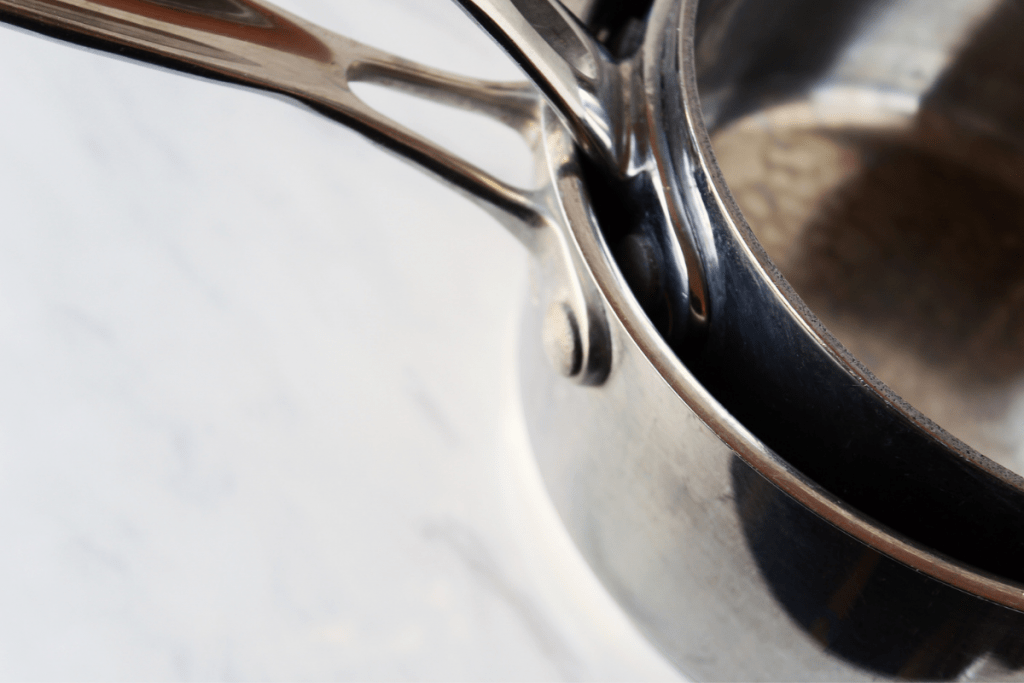I cook almost every meal for my two year old daughter. It wasn’t until she arrived at the family table that I became concerned about what the healthiest and safest cookware was.
Even though we look at children as being fragile and susceptible to environmental toxins, the chemical or metal composition of some cookware can have negative effects on all of us.
I’m going to help you understand what your cookware is made from and how it can impact your health and safety. With a little knowledge of the materials and how they function, you’ll be prepared to make an informed decision on what’s best for you.
Read on to learn about the best materials for nontoxic cookware.
In This Article
Stainless Steel
Stainless steel is an ideal cookware material when it comes to health and safety. It’s a non-reactive and non-porous material that is safe to use with all ingredients. On top of that it’s durable and versatile enough for just about any cooking task.

Why you should choose stainless steel
It’s durable
Stainless steel is the preferred cookware material in most professional kitchens due to its durability. There are no chemical coatings to worry about, and rust is almost never an issue. You’re also free to use all of your utensils including metal.
When you’re cooking, its great to focus on the food and not have to worry about damaging the pan you’re using. My All-Clad pots and pans get a lot of use in my kitchen, but after a good cleaning they could pass for new.
It’s versatile
Cooking with stainless steel can take some practice to master, but once you do, you can use it for everything. Most options are oven safe, and can be used on any type of cooking surface, including induction. Once you get a hang of it, you’ll even be turning out perfect eggs with no mess to clean up after.
It’s easy to clean
If you look in most restaurant kitchens you’ll find most of the tables and even walls are made from stainless steel. That’s because it’s a non-porous material that can’t absorb anything. This makes it easy to clean and bacteria has a hard time growing on it.
What are the drawbacks of stainless steel?
It can be expensive
All-Clad is one of the more expensive brands, but they do offer all of their pieces individually so you can add pieces to your collection over time. Calphalon is an excellent option for a high-performing but much more affordable alternative.
It’s not nonstick
Stainless steel takes some practice before you’re really good with it. Many owners are quickly discouraged because food can stick without the right technique. But, if you stick with it and can learn to cook with stainless steel, you’ll be set for life.
Possibility of leaching
Stainless steel is an alloy made from iron, chromium, and often nickel. It’s believed to be quite safe but both metals can leach into food while cooking. If you have a severe allergy to either, it may be worth consulting a medical professional.
Cast Iron
Cast iron is heavy-duty, heats evenly, and holds heat better than anything else. This is another choice that doesn’t come with any coatings to worry about or wonder what they’re made from.
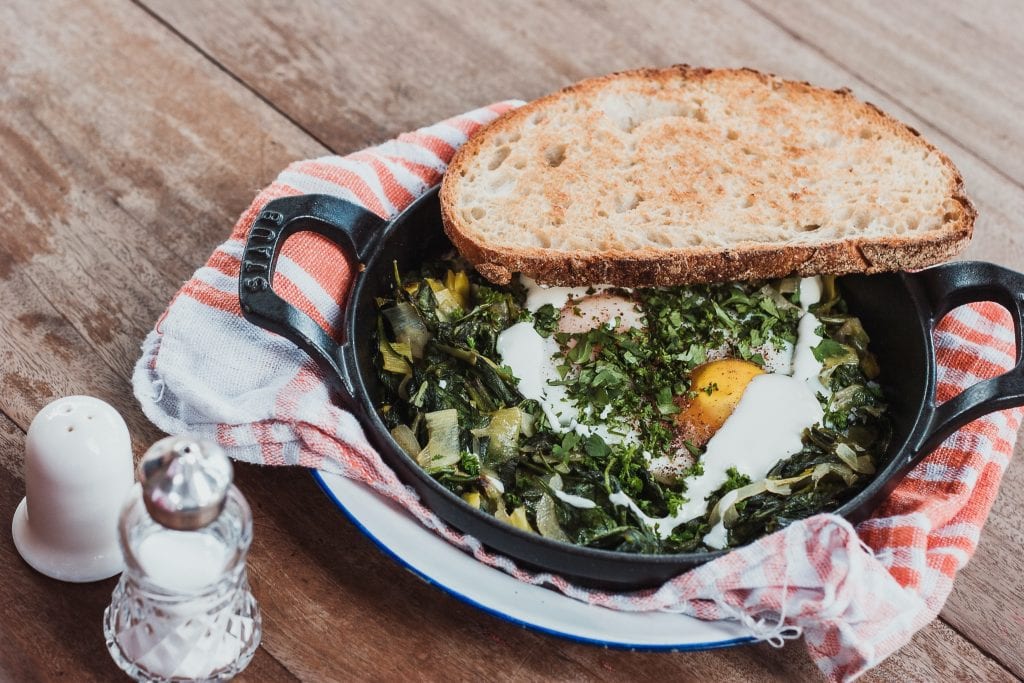
Why you should choose cast iron
It’s durable
Cast iron is thick and very heavy, making it next to impossible to dent or warp, plus metal utensils are no problem. A cast iron skillet will last for generations, so If you’re not lucky enough to have inherited one from an old relative, consider buying one to start the tradition.
It’s inexpensive
You can easily get a 10 or 12-inch cast iron skillet for less than $20, and it will likely outlast you and me. Lodge is a great brand to get started with and it’s what I’ve been using for years.
What are the drawbacks of cast iron?
Requires some maintenance
Raw cast iron requires regular seasoning to prevent rust and decay. You must also take care when cleaning cast iron. These pieces must be hand washed, and the use of soap can strip the seasoning on your cookware.
It can leach iron
A good seasoning will help to avoid this, but iron can leach into your food especially when cooking high acid foods like tomatoes. On the other hand, some people will benefit from additional iron in their diets.
It’s heavy
While it’s thickness and weight can be great when it comes to cooking, it also makes cast iron quite heavy. A common 12-inch skillet often weighs over 7-pounds, and that’s before it’s full of food.
Carbon Steel
Carbon steel is like cast iron’s much lighter cousin. It’s another raw and uncoated material so you don’t have to worry about any chemicals or other mystery ingredients. In my house, it’s the pan I reach for instead of a traditional nonstick pan, and a hundred other uses.
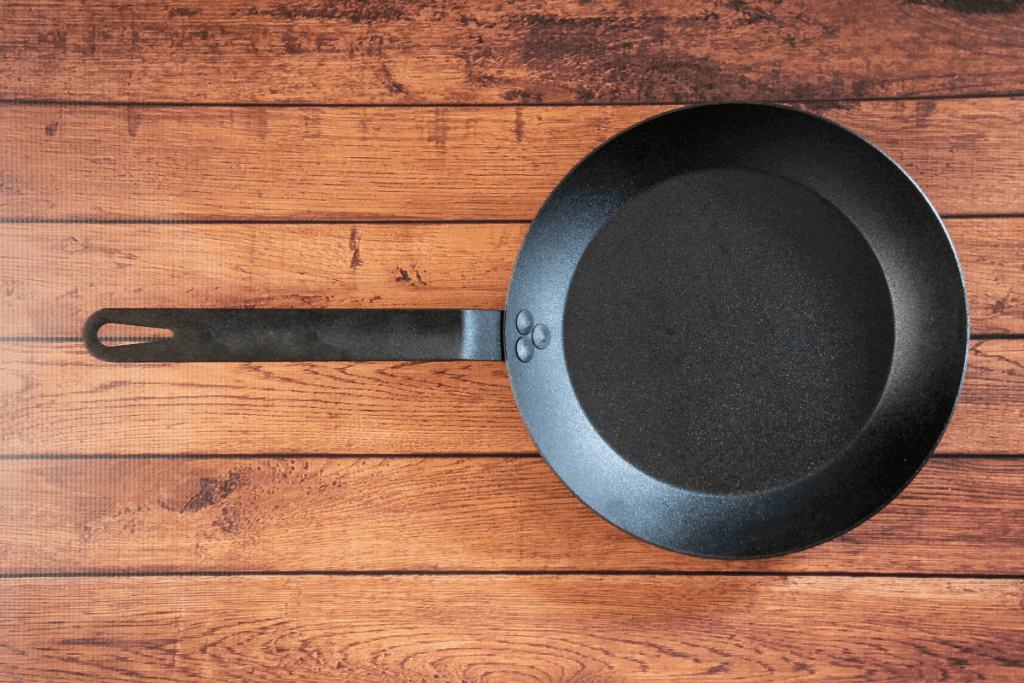
Why you should choose carbon steel
It’s durable
You may have noticed that all of our top three picks have durability in common. Something you won’t find in most nonstick coated cookware.
Cookware that lasts is great because you don’t have to replace it very often, and because you don’t have to worry about any coatings that can wear down and enter your food.
It can replace your coated nonstick pan
Similar to cast iron, carbon steel must be seasoned in order to protect against corrosion. But, once you have a really good seasoning you’ll have eggs sliding around your pan like it was coated in Teflon.
A light-weight alternative to cast iron
One of the downsides of traditional cast iron cookware is that they are very heavy. Carbon steel functions very similarly but in a much lighter weight package. It can be a little more expensive than cast iron, but even our pick for the best budget carbon steel pan can handle anything you throw at it.
What are the drawbacks of carbon steel?
Maintenance is required
Just like with cast iron, carbon steel must be seasoned and also hand washed. I think this is one of the reasons more people haven’t embraced carbon steel in their homes. We offer some great information on caring for carbon steel, and I think once give it a try, you’ll be a convert for life.
Few options outside of fry pans
If its a frying pan you’re looking for then you’re in luck. You can find a huge selection of carbon steel frying pans, but if you’re looking for saucepans and stock pots, you’ll have a hard time finding many options.
It can leach iron
Again, just like with cast iron, iron can leach into your food. Maintaining a good seasoning and limiting exposure to acidic ingredients will go far in reducing that reaction.
Copper
Copper is the best conductor of heat around so it makes sense that it’s used for cookware. But, it’s also very expensive and very reactive. Since copper is toxic when consumed, almost all copper cookware made today is lined with tin or stainless steel. Lined copper is what I’m referring to here as a good and safe choice for your kitchen.
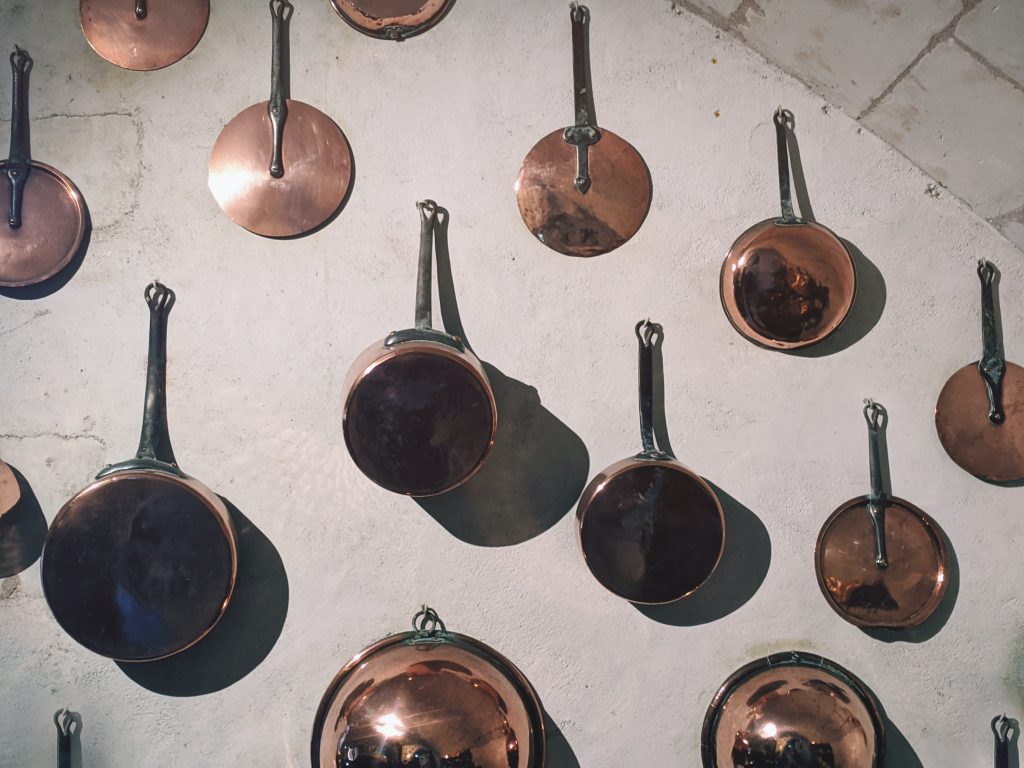
Why you should choose copper
It’s the best heat conductor
Good conductivity is one of the goals of most cookware, and that’s why copper is king. It heats quickly, evenly and adjusts to temperature changes better than anything else.
It looks great
Polished copper cookware is what dreams are made of…ok, maybe that’s just me. But, it’s hard to deny how beautiful a kitchen full of gleaming copper is.
What are the drawbacks of copper?
It’s very expensive
I was spoiled when I worked in a restaurant that used exclusively Mauviel cookware. Then I was devastated when I discovered I would likely never use it in my own home. Lined copper cookware is beautiful and a joy to cook with, but it’s hard to find the good stuff for less than $200 per piece, and it can go up quickly from there.
Some options can still leach into food
Good stainless steel line copper is a really safe bet to protect against leaching. You do have to look out for copper cookware lined with tin. Tin is not nearly as durable as stainless steel, so if the tin lining is damaged you could end up exposing your food directly to the copper.
Anodized Aluminum
Aluminum is another excellent heat conductor and it costs a fraction of the price of copper. Raw aluminum is very reactive and can easily leach into food. Anodized aluminum give you all the performance benefits of aluminum in a more durable and less reactive package.

Why you should choose anodized aluminum
It’s inexpensive
Anodized aluminum is more expensive than the untreated stuff but its still very affordable. It’s easy to find a full set with everything you need for around a hundred dollars.
It’s an excellent heat conductor
Aluminum conducts heat exceptionally well, second only to copper. If you’re not timing the two side by side, you won’t be able to tell that the aluminum option boiled water 30 seconds slower than copper may have.
What are the drawbacks of anodized aluminum?
It’s not that durable
Anodization gives a lot of strength to aluminum, but it is still susceptible to bending and warping. Have you ever had a pot or pan that wobbles and spins on your stove top? My guess is it was an aluminum pan that was warped from high heat, or even normal use.
It can still leach into food
The anodized surface is a protective layer but that layer can be worn away, exposing you to the raw aluminum underneath. The process can happen rather quickly with heavy dishwasher use.
It often has nonstick coatings
Anodized aluminum is the most widely used material for nonstick cookware. In these cases its not the aluminum but the nonstick surface you may have to worry about.
Ceramic Nonstick
Ceramic nonstick is easy to use right out of the box, no seasoning or other special steps required. It’s often marketed as a “healthy alternative” to traditional (Teflon) nonstick cookware. It’s true that many brands make their products without potentially dangerous chemicals or heavy metals, but there is no law that requires it.
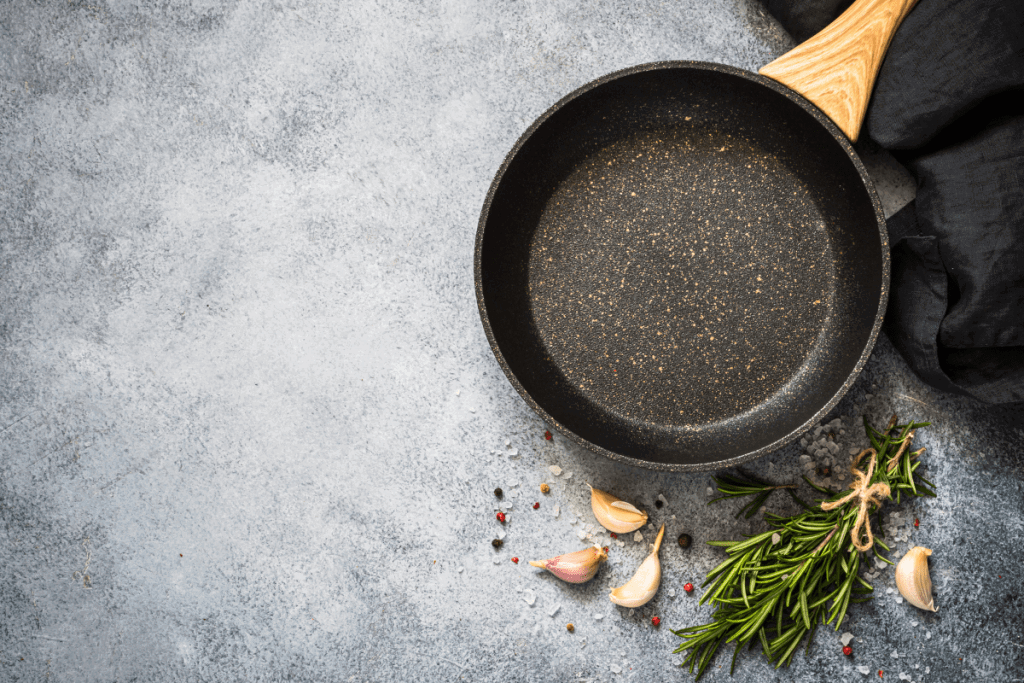
Why you should choose ceramic nonstick
It’s convenient and easy to use
There’s no seasoning or special techniques needed when cooking with nonstick cookware. You take it out of the box and you’re ready to go. Then when it’s time to cleanup, a soft cloth and soapy water is usually all you need.
It’s inexpensive
Most options are built on top of an aluminum pot or pan. As we mentioned earlier, aluminum is very inexpensive but also offers good cooking performance and conductivity.
It can be a safer alternative to traditional nonstick
It may take some effort, but you can find good options that don’t contain any potentially dangerous chemicals or materials. Luckily, we’ve done all the hard work for you and rounded up some of the best nonstick pans without Teflon.
What are the drawbacks of ceramic nonstick
It’s not very durable
We’ve done hours of research and loads of reviews of ceramic nonstick cookware. When it comes to the nonstick properties we have found that most options last between one and two years, with proper use and care. And many choices are much less than that.
You can’t use metal utensils
Some companies claim that their nonstick coating is so strong that you can use a knife, or crush rocks in the pan. My advice is never listen to them, and only use wood or silicon tools. Even though crushing rocks directly in the pan may save you a little time, it’s going to greatly reduce the life of your cookware.
It’s hard to know what’s in each nonstick coating
Many brands make claims like “100% natural” or “chemical free”, its very difficult to know exactly what’s in each recipe. If you’re concerned about a specific material, it may be necessary to contact a company directly to get a truthful answer.
Nonstick (PTFE/Teflon)
Traditional nonstick cookware is the gold standard when it comes to nonstick cooking. If all you’re looking for is convenience and ease of use, this is probably the way to go. But, it’s important to know that there are some potential negative environmental effects associated with this choice.
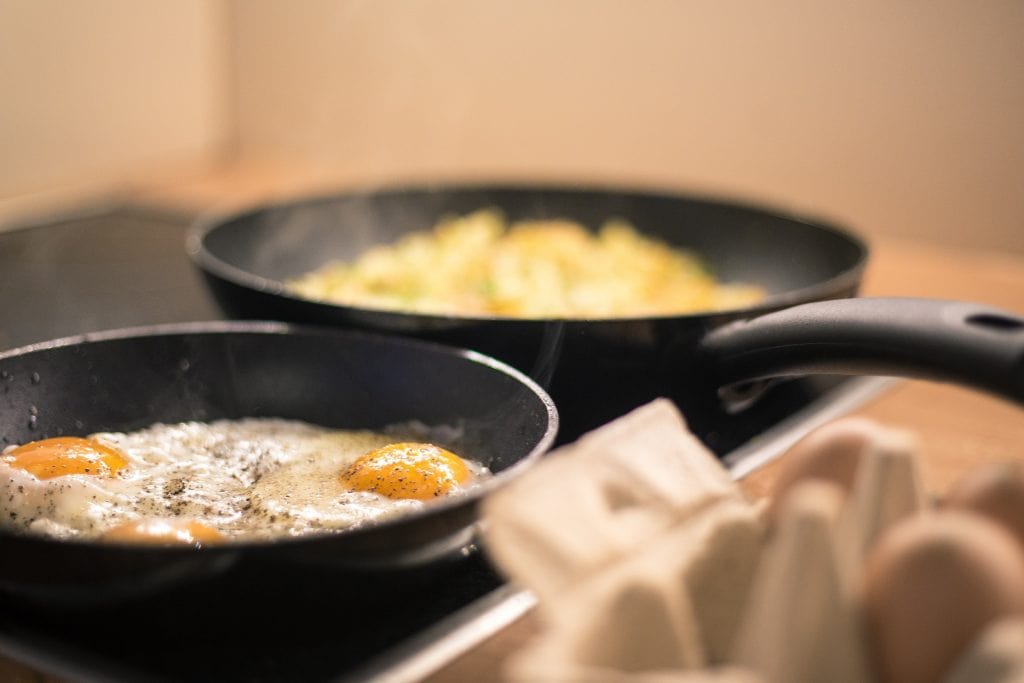
Why you should choose PTFE nonstick
It’s the best when it comes to food release
It might be obvious, but the main reason for using nonstick cookware is so food won’t stick when you’re cooking. That’s going to make it harder to burn and ruin the food you’re cooking, and cleanup is only a matter of wiping out your pan.
It’s a more durable nonstick option
Nonstick cookware isn’t known to be passed from generation to generation. But, through our extensive research we’ve found that good PTFE-nonstick like this pan from Calphalon can give a solid five years of use. That’s significantly longer than some of the best ceramic options which have a hard time making it passed two.
What are the drawbacks of PTFE nonstick?
Potential environmental risks
The big concern with PTFE nonstick is that it releases toxic fumes at high temperatures. The risk of serious danger to your health is low as long as you follow the guidelines that accompany your cookware. If you have pet birds on the other hand, you may want to look elsewhere, as they have been shown to be very sensitive any toxins being emitted.
It will need to be replaced
PTFE nonstick may be more durable than ceramic, but its useful life is still limited. Even when cared for properly, the nonstick surface will begin to fade and will need to be replaced.
What is the safest cookware option?
It’s great to have a variety of cookware options in your kitchen, but when it comes to health and safety, stainless steel is the way to go. Very little nickel or chromium are leached into food and only in very specif instances. If you’re very sensitive to either of those materials it could pose an issue, but for most this is the safest choice.
With stainless steel there are no additional steps or care required in order to make and keep the cookware safe. It’s good to go, out of the box and should be built to last.
Cast iron and carbon steel are the next best choice. The only reason they come in below stainless steel is that they take a little work to avoid corrosion and rust. Similarly, if you have a sensitivity or hemochromatosis you should avoid raw iron cookware.
How much is it going to cost?
Stainless steel can be pricey, especially when you’re looking at the high-end options. The more expensive choices will be fully clad, meaning they have multiple layers of metal throughout the cookware.
This helps them to heat more evenly and adds durability. All good things, but all at a cost.
Top end options like the American made All-Clad start at around $1000 for a 10-piece set. Luckily they also sell all of their pieces individually, so you can add cookware as you need and when you can. Their smallest sized pots and pans start around $100 and go up from there.
I have several pieces of All-Clad that I purchase through Home and Cooks Sales. They sell genuine products that have slight defects which have no effect on performance. The savings can be considerable but they don’t offer full collections and availability can be inconsistent. On top of that they do not include the usual lifetime warranty.
Calphalon is a great and more affordable choice when it comes to cladware. They have done a great job emulating All-Clad products, and offer them for about half the price. They Are able to do that by outsourcing production to China.
The pieces are still high performing and built to last. We recently did a comparison of the brands which gives a good idea about the tradeoffs between brand and price.
Health and safety controversies you should be aware of.
Toxin release from Teflon coated cookware
Teflon is the brand name of Polytetrafluoroethylene (PTFE). This is the primary chemical used in making traditional nonstick cooking surfaces, and it makes things exceptionally slippery and nonstick.
When Teflon is heated to temperatures around 500 f and above they begin to break down and can emit toxic fumes into the air.
The use of dangerous PFOAs in cookware have widely been disbanded. Unfortunately there is already a so-called “sustainable replacement” called GenX.
GenX chemicals are relatively new and there are still a lot of unknowns about its safety and effects on the environment.
There is a seemingly endless amount of information on the health and safety of Traditional nonstick. In 2020 we did a deep dive on Forever Chemicals and uncovered a wealth of interesting facts and useful information.
Metal leaching
Cast iron, carbon steel, raw aluminum, and copper all have the potential to leach into food during the cooking process.
Cast iron and carbon steel can both leach iron into food. In general, iron is a beneficial part of your diet, and the amount added from the cookware is no problem. I know someone who was actually prescribed to cook with cast iron by a doctor because they were anemic.
Since almost all copper cookware today is lined with non-reactive cooking surfaces its a pretty safe bet. If you come across antique copper cookware that is unlined, extra precautions are necessary for safe use.
Stainless steel is very safe but can leach small amounts of nickel and chromium into food. There are only real health concerns for those with extreme sensitivities to those metals.
Aluminum is prone to leaching, but anodized options do a great job of eliminating that risk. Some have concerns that aluminum increases or leads to Alzheimer’s disease, but there is currently no strong evidence to support that. However, it can be beneficial to understand how heavy metals are stored and can affect our health.
Our Recommendations
No cookware is 100% safe for all users and situations. By better understanding all of your options you will be better prepared to make an informed decision for your household.
Using cookware made from materials we understand are always the safest bet. For that reason I almost exclusively use stainless steel, cast iron, and carbon steel in my home.
Not only do I know what each one is made from, but I also know that I’ll likely never have to replace them.
There’s no doubt that nonstick cookware can be the most convenient option in the kitchen, but if you’re concerned about the chemicals involved, consider one of these best nonstick pans without Teflon.
